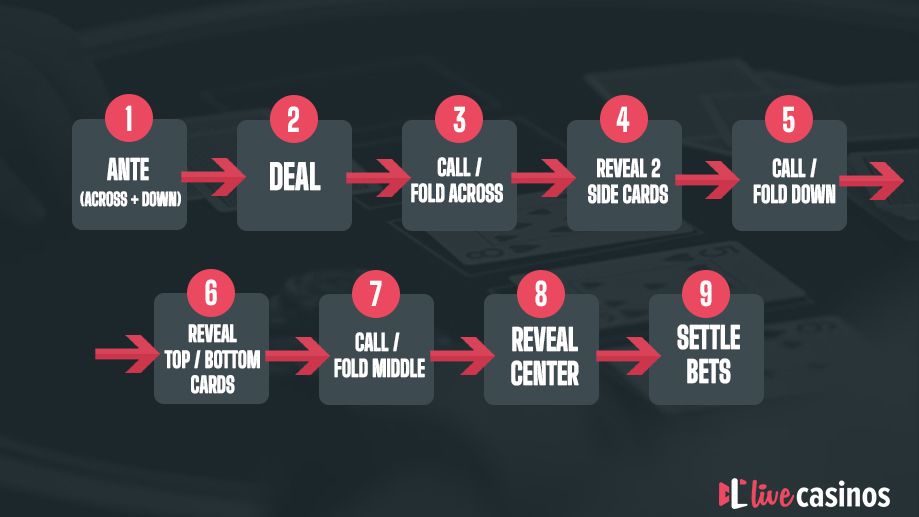Criss Cross Poker is not an overly complicated game, but it’s quite unique compared to most other types of casino poker. It may take a few turns to get accustomed to the flow.
Here’s a step-by-step breakdown of how a single round of Criss Cross poker works.
- Step 1 – Ante Bets: To participate, the player must make two equal Ante bets: Ante Across and Ante Down. An optional side bet called 5-Card Bonus is also available.
- Step 2 – The Deal: The dealer will hand the player two hole cards and place five community cards face down in a cross pattern.
- Step 3 – Across Decision: The player chooses whether to Call, Raise or Fold the Across bet, based on their hole cards. This bet uses the hole cards and the three horizontal community cards to make poker hands.
- If you choose to Fold, the Ante Across bet loses.
- If you choose to Call, you continue the round and wager the same stake you used for the Ante Across.
- If you choose to Raise, you continue the round and wager 3x the stake you used for the Ante Across.
- Step 4 – Across Reveal: The dealer flips over the two cards on the left and the right of the cross pattern.
- Step 5 – Down Decision: The player chooses whether to Call, Raise, or Fold the Down bet. This bet uses the hole cards and the three vertical community cards to make poker hands. Otherwise, it’s identical to the Across bet.
- Step 6 – Down Reveal: The dealer flips over the two cards on the top and bottom of the cross pattern.
- Step 7 – Middle Decision: The player chooses whether to Call, Raise, or Fold the Middle bet. The Middle bet pays according to either the vertical or horizontal cards, whichever has a stronger hand.
- Step 8 – Middle Reveal: The dealer flips over the card in the middle of the cross pattern.
- Step 9 – Resolve Bets: All bets (both Ante bets; Across, Down, and Middle bets) are resolved.
- If the relevant cards don’t form at least a Pair of 6s or higher, all bets that use those cards lose.
- If the relevant cards form a Low Pair (6-10), the bets that use those cards push and the full stake for them is returned to the player.
- If the relevant cards form a High Pair (Jacks or higher) or better, the Ante bet that uses those cards pays 1:1. Across, Down, and Middle bets pay according to the paytable, with stronger hands offering higher payouts.

5-Card Bonus Side Bet
Most Criss Cross Poker tables also offer an optional side bet called the 5-Card Bonus.
This bet uses all 5 community cards to form poker hands. If these cards form a Pair of 6s or better, the bet wins.
The 6-Card Bonus wager pays according to a separate paytable. Stronger hands offer higher payouts, up to 250:1 for a Royal Flush.
Standard Criss Cross Poker Payouts
Ante Bets
Both the Across Ante and Down Ante bets have exactly three possible outcomes:
- If your hole cards and the Across/Down community cards form a pair of Jacks or better, the Across/Down Ante bet wins 1:1.
- If your hole cards and the Across/Down community cards form a pair of Jacks, Queens, Kings, or Aces, the Across/Down Ante bet pushes, and its full stake is returned to you.
- In all other outcomes, the Across/Down Ante bet loses.
Across/Down/Middle Bets
The non-Ante bets pay according to the paytable below.
All three wagers (Across, Down, and Middle) offer the same payouts. These may vary from table to table. The payouts listed below are by far the most common, though.
Hands in Criss Cross Poker are formed using standard rules you would find in any game of poker. If you’re not sure how they work, check out this comprehensive guide.
Optional 5-Card Bonus (community cards only)
The 5-Card Bonus side bet pays according to the five community cards – your hole cards are irrelevant.
It can win or lose regardless of the outcome of the Ante and Main bets.
The 5-Card Bonus side bet has a house edge of ~3.53%, which is very low for a casino poker side bet.
Odds, House Edge & Volatility (what to expect)
All three bets in this game can have a lot of possible outcomes. They can win with multiple possible outcomes (hands). They can also be raised, which increases the total payout compared to the Ante bet.
The table below shows every possible outcome in Criss Cross poker, listing its probability and total payout relative to the initial Ante bet. Note that Down and Across bets also pay a return on the Ante, which is why they pay 1 unit more than the Middle bet.
- Assuming you’re using the outlined strategy, Criss Cross Poker shows a House Edge percentage of 4.33% based on both Ante bets combined.
- This translates into a Return-to-Player rate (RTP) of 95.66%.
- Additionally, players should keep in mind that the average round of Criss Cross poker (assuming optimal strategy) requires the player to bet 5.867x a single Ante bet.
- The fact that stakes can be raised for all three bets increases the effective expected value and brings the house edge down to 1.48%.
- In other words, Criss Cross Poker shows an element of risk of 1.48%.
- However, the Wizard of Odds’ calculations also show a high degree of standard deviation (4.802 relative to the initial wager, which is two Ante bets.) In other words, swings between wins and losses can be quite large and feel volatile.
Criss Cross Poker Strategy
Criss Cross Poker allows players to actively make decisions that can impact the outcome. As such, the best strategy for this game is knowing when to Call, when to Fold, and when to Raise.
Making optimal decisions ensures that you’re minimising the casino’s advantage down to the minimum of 4.33% (1.48% if accounting for the element of risk).
If you do not follow the strategy outlined below, the probabilities listed above will be different, resulting in a higher house edge.
Here’s how you should make every decision in Criss Cross Poker at different points in the round.
Across (before any community cards are shown)
- If your hole cards are not a pair, are of different suits, and the higher card is 5 or less, you should Fold.
- If your hole cards are any pair or a combination of a Jack and a Queen of the same suit, you should Raise (3x).
- In all other situations, you should Call (1x).
Down (after two Across cards are revealed)
Optimal decisions for the Down bet are largely the same as the Across bet.
However, you should note that you’ve seen 2 additional cards at this point. This knowledge can potentially be leveraged to make different decisions in highliy specific, marginal cases.
For example, let’s say your hole cards are a suited 10 and Jack. If the Across cards are of different suits, you’ll know that your chances of hitting a strong winning hand (Flush or Straight Flush) are slightly higher. You may want to consider raising instead of calling the bet.
Knowing the optimal marginal decisions for the Down bet can effectively reduce the house edge of this wager by around 0.15% relative to the Ante Down bet.
Experienced poker players are able to spot these fringe cases and take advantage of them. If you can’t, we recommend sticking to the same rules we outlined for the Across bet.
Middle (after four community cards are up)
The Middle bet is by far the most varied in terms of what, how, and when it can it made. Since it always uses the better of two hands, it has a noticeably higher chance of winning.
Our probability table (and optimal strategy) is based on the following rules:
- If you Raise either the Across or Down bets, never Fold the Middle bet.
- Fold the Middle bet if neither the Across nor the Down bet manage to form at least a Medium Pair after the first four Hole cards have been revealed. This accounts for around 4.5% of cases.
- If either the Across or Down cards (community + hole) form a medium or high pair before the last card is revealed , you should Raise.
- If your hole cards and either the Across or Down community cards are 1 card short of a Straight or Flush, you should Raise.
- If either the Across or Down cards are a low pair, you should Call.
- If at least three shown cards (community + hole) are Jacks or higher, you should Call.









































 Roulette
Roulette
 Blackjack
Blackjack
 Baccarat
Baccarat
 Poker
Poker
 Sic Bo
Sic Bo
 Dragon Tiger
Dragon Tiger
 Game Shows
Game Shows  Top 5 Games
Top 5 Games  See more
See more  Roulette Casinos
Roulette Casinos  Low Limit
Low Limit  High Limit / VIP
High Limit / VIP  Exclusive
Exclusive  How to Play
How to Play  Basic Strategy
Basic Strategy  Top Tips
Top Tips  FAQ
FAQ  Blackjack Casinos
Blackjack Casinos  Baccarat Casinos
Baccarat Casinos  Bonuses
Bonuses  Poker Casinos
Poker Casinos  Game Providers
Game Providers  Sic Bo Casinos
Sic Bo Casinos  Dragon Tiger Casinos
Dragon Tiger Casinos  Credit and Debit Card
Credit and Debit Card  e-Wallet
e-Wallet  Cryptocurrency
Cryptocurrency  Bank and Checks
Bank and Checks  Pay by Phone and SMS
Pay by Phone and SMS  See more
See more  How-To Guides
How-To Guides  Top Lists
Top Lists  In-Depth
In-Depth  Strategy
Strategy  Casino & Games
Casino & Games  Insight
Insight  News
News  Promotions
Promotions 
 Guide to Live Casinos
Guide to Live Casinos  Top 10 Live Casino Tips
Top 10 Live Casino Tips  Studio Locations
Studio Locations  FAQ & Help
FAQ & Help  Meet The Dealers
Meet The Dealers  Our Awards
Our Awards  How We Rate
How We Rate  Responsible Gambling
Responsible Gambling 




























 ENG
ENG 







 Facebook
Facebook
 Pinterest
Pinterest
 Twitter
Twitter
 LinkedIn
LinkedIn
 Copy Link
Copy Link 




















